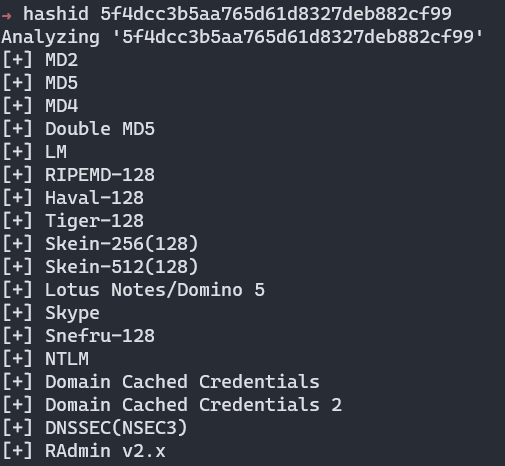Name-That-Hash v1.11 releases: The Modern Hash Identification System

Name-That-Hash
What is this?
Have you ever come across a hash such as 5f4dcc3b5aa765d61d8327deb882cf99 and wondered what type of hash that is? 🤔
Name-that-hash will name that hash type!
🔥 Features
- 📺 Popularity Ratings – Name that hash will show you the most popular hashes first. In older systems, it would prioritise Skype Hash the same as Active Directory’s NTLM! Which makes as much sense as saying that my GitHub is as popular as VSCode 📈
- ✍ Hash Summaries – no more wondering whether it’s MD5 or NTLM. It will summarise the main usage of each hash, allowing you to make an informed & decisive choice ⚡
- 🌈 Colour Output – Don’t worry, the colours were hand-selected with a designer to be 100% accessible and gnarly 😎
- 🤖 JSON output && API – Want to use it in your project? We are API first, CLI second. Use JSON output or import us as a Python module! 💾
- 👵 Updated! – HashID was last updated in 2015. Hash-Identifier in 2011! It is a 2021 project 🦧
- ♿ Accessible – We are 100% committed to making this an accessible hacking tool 🙏
- 🎫 Extensible – Add new hashes as quickly as you can edit this README. No, seriously — it’s that easy! 🎱
Name-That-Hash vs HashID vs Hash-Identifier
| Features | Name-That-Hash | HashID | Hash-Identifier |
|---|---|---|---|
| Last updated | 2021, check commits. | 17/03/2015 | 30/09/2011 |
Feature Comparison
Here HashID displays Skype before NTLM, whereas Name-That-Hash understands the popularity of hashes so places NTLM before Skype.
📕 You can also see Name-That-Hash displaying a summary, whereas HashID doesn’t. In the default view it also displays John + HashCat information. Because let’s face it, the only reason you’re using this tool is to figure out what to put into HashCat! 🐱🚀
Name-That-Hash is radically different from HashID, I’m not going to list all the differences — you can physically see them yourselves 😎
💌 Accessibility
Name-That-Hash is an accessible hacking tool. That means we spent time designing things, such as…
Removing the ASCII Art of very long “least likely” text blocks using –accessible.
Doing this means you don’t get access to the least likely, and if the hash is in that pile it’d suck. So we also have –no-banner.
Which removes the ASCII art banner.
Changelog v1.11
- update descrypt regex (#142) @roycewilliams
- Add various regexes from community contribution stream (#141) @goproslowyo
- Add regex and test for yescrypt (#139) @goproslowyo
- Bump rich from 12.0.0 to 12.0.1 (#136) @dependabot
- Add BitLocker and RACF hash types (#127) @ellygaytor
- Update CI and dependencies (#135) @amadejpapez
- Bump rich from 10.7.0 to 10.11.0 (#125) @dependabot
- Bump pytest from 6.2.4 to 6.2.5 (#123) @dependabot
- Bump rich from 10.4.0 to 10.7.0 (#121) @dependabot
- Bump rich from 10.3.0 to 10.4.0 (#118) @dependabot
- Added john mode to argon2i and argon2d (#117) @amadejpapez
- More hashcat tests, Argon2 hash support and some cleaning (#115) @amadejpapez
- Add new github action runners (#114) @bee-san
- Added a test for each hashcat mode, updated the database (#113) @amadejpapez
Install & Use
Copyright (C) 2021 HashPals








